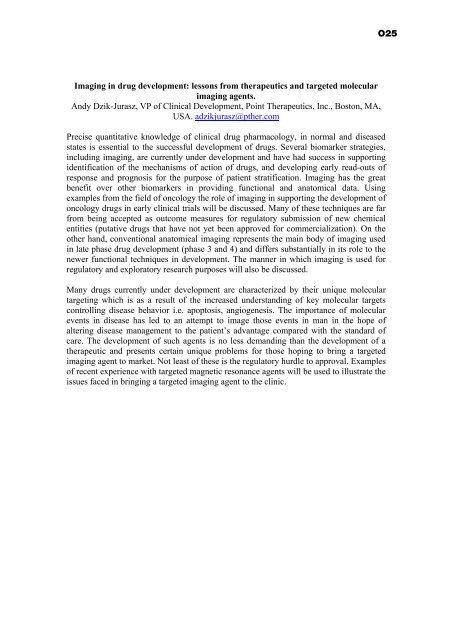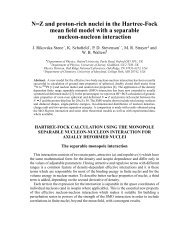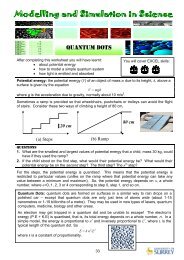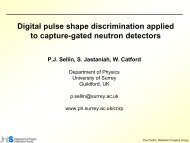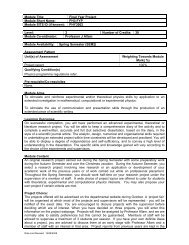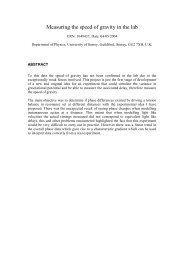Proceedings of the meeting - Department of Physics - University of ...
Proceedings of the meeting - Department of Physics - University of ...
Proceedings of the meeting - Department of Physics - University of ...
Create successful ePaper yourself
Turn your PDF publications into a flip-book with our unique Google optimized e-Paper software.
O25Imaging in drug development: lessons from <strong>the</strong>rapeutics and targeted molecularimaging agents.Andy Dzik-Jurasz, VP <strong>of</strong> Clinical Development, Point Therapeutics, Inc., Boston, MA,USA. adzikjurasz@p<strong>the</strong>r.comPrecise quantitative knowledge <strong>of</strong> clinical drug pharmacology, in normal and diseasedstates is essential to <strong>the</strong> successful development <strong>of</strong> drugs. Several biomarker strategies,including imaging, are currently under development and have had success in supportingidentification <strong>of</strong> <strong>the</strong> mechanisms <strong>of</strong> action <strong>of</strong> drugs, and developing early read-outs <strong>of</strong>response and prognosis for <strong>the</strong> purpose <strong>of</strong> patient stratification. Imaging has <strong>the</strong> greatbenefit over o<strong>the</strong>r biomarkers in providing functional and anatomical data. Usingexamples from <strong>the</strong> field <strong>of</strong> oncology <strong>the</strong> role <strong>of</strong> imaging in supporting <strong>the</strong> development <strong>of</strong>oncology drugs in early clinical trials will be discussed. Many <strong>of</strong> <strong>the</strong>se techniques are farfrom being accepted as outcome measures for regulatory submission <strong>of</strong> new chemicalentities (putative drugs that have not yet been approved for commercialization). On <strong>the</strong>o<strong>the</strong>r hand, conventional anatomical imaging represents <strong>the</strong> main body <strong>of</strong> imaging usedin late phase drug development (phase 3 and 4) and differs substantially in its role to <strong>the</strong>newer functional techniques in development. The manner in which imaging is used forregulatory and exploratory research purposes will also be discussed.Many drugs currently under development are characterized by <strong>the</strong>ir unique moleculartargeting which is as a result <strong>of</strong> <strong>the</strong> increased understanding <strong>of</strong> key molecular targetscontrolling disease behavior i.e. apoptosis, angiogenesis. The importance <strong>of</strong> molecularevents in disease has led to an attempt to image those events in man in <strong>the</strong> hope <strong>of</strong>altering disease management to <strong>the</strong> patient’s advantage compared with <strong>the</strong> standard <strong>of</strong>care. The development <strong>of</strong> such agents is no less demanding than <strong>the</strong> development <strong>of</strong> a<strong>the</strong>rapeutic and presents certain unique problems for those hoping to bring a targetedimaging agent to market. Not least <strong>of</strong> <strong>the</strong>se is <strong>the</strong> regulatory hurdle to approval. Examples<strong>of</strong> recent experience with targeted magnetic resonance agents will be used to illustrate <strong>the</strong>issues faced in bringing a targeted imaging agent to <strong>the</strong> clinic.


